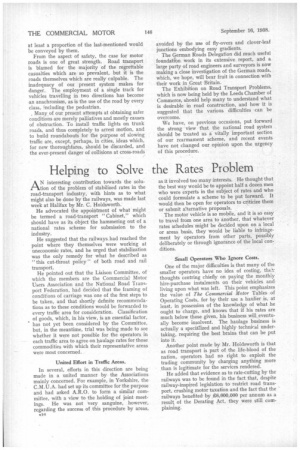Helping to Solve the Rates Problem
Page 26

If you've noticed an error in this article please click here to report it so we can fix it.
AN interesting contribution towards the solution of the problem of stabilized rates in the road-transport industry, with hints as to what might also be done by the railways, was made last week at Halifax by Mr. C. Holdsworth.
He advocated the appointment of what might be termed a road-transport "Cabinet," which should have as its object the hammering out of a national rates scheme for submission to the industry.
He suggested that the railways, had reached the point where they themselves were working at uneconomic rates, and he urged that stabilization was the only remedy for what he described as "this cut-throat policy" of both road and rail transport.
He pointed out that the Liaison Committee, of which the members are the Commercial Motor Users Association and the National Road Transport Federation, had decided that the framing of conditions of carriage was one of the first steps to be taken, and that shortly definite recommendations as to these conditions would be forwarded to every traffic area for consideration. Classification of goods, which, in his view, is an essential factor, has not yet been considered by the Committee, but, in the meantime, trial was being made to see whether it were not possible for the operators in each traffic area to agree on haulage rates for those commodities with which their representative areas were most concerned.
United Effort in Traffic Areas.
In several, efforts in this direction are being made in a united manner by the Associations mainly concerned. For example, in Yorkshire, the C.M.U.A. had set up its committee for the purpose and had asked A.R.O. to form a similar committee, with a view to the holding of joint meetings. He was not very sanguine, however, regarding the success of this procedure by areas, iiin as it involved too many interests. He thought that the best way would be to appoint half a dozen men who were experts in the subject of rates and who could formulate a scheme to be put forward. It would then be open for operators to criticize them or submit alternative proposals.
The motor vehicle is so mobile, and it is so easy to travel from one area to another, that whatever rates schedules might be decided upon on a local or areas basis, they would be liable to infringement by operators from other parts, possibly deliberately or through ignorance of the local conditions.
Small Operators Who Ignore Costs.
One of the major difficulties is that many of the smaller operators have no idea of costing, the:-: thoughts centring chiefly on paying the monthly hire-purchase instalments on their vehicles and living upon what was left. This point emphasizes the value of The Commercial Motor Tables of Operating Costs, for by their use a haulier is, at least, in possession of the knowledge of what he ought to charge, and knows that if his rates are much below those given, his business will eventually become insolvent. The haulage business is actually a specillized and highly technical undertaking, requiring the best brains that can be put into it.
Another point made by Mr. Holdsworth is that as road transport is part of the life-blood of the nation, operators had no right to exploit the trading community by charging anything more than is legitimate for the services rendered.
He added that evidence as to rate-cutting by the railways was to be found in the fact that, despite railway-inspired legislation to restrict road transport, crushing motor taxation and the fact that the railways benefited by £6,000,000 per annum as a result of the Derating Act, they were still complaining.




















































































